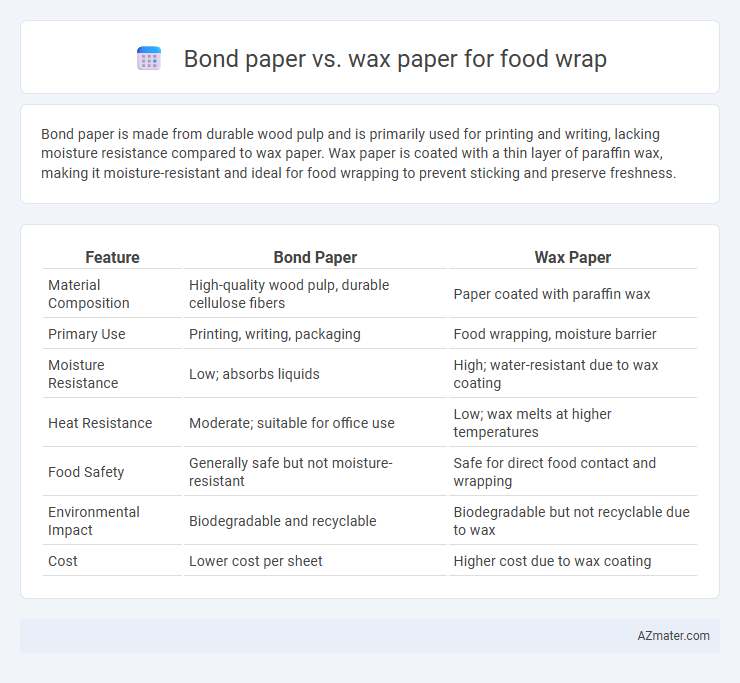Bond paper is made from durable wood pulp and is primarily used for printing and writing, lacking moisture resistance compared to wax paper. Wax paper is coated with a thin layer of paraffin wax, making it moisture-resistant and ideal for food wrapping to prevent sticking and preserve freshness.
Table of Comparison
| Feature | Bond Paper | Wax Paper |
|---|---|---|
| Material Composition | High-quality wood pulp, durable cellulose fibers | Paper coated with paraffin wax |
| Primary Use | Printing, writing, packaging | Food wrapping, moisture barrier |
| Moisture Resistance | Low; absorbs liquids | High; water-resistant due to wax coating |
| Heat Resistance | Moderate; suitable for office use | Low; wax melts at higher temperatures |
| Food Safety | Generally safe but not moisture-resistant | Safe for direct food contact and wrapping |
| Environmental Impact | Biodegradable and recyclable | Biodegradable but not recyclable due to wax |
| Cost | Lower cost per sheet | Higher cost due to wax coating |
Introduction: Comparing Bond Paper and Wax Paper for Food Wrapping
Bond paper, typically used for printing and writing, lacks moisture resistance and is not designed for direct food contact, making it unsuitable for food wrapping. Wax paper is coated with a thin layer of paraffin wax, providing a non-stick, moisture-resistant barrier ideal for wrapping food items to maintain freshness and prevent leakage. Choosing wax paper over bond paper for food wrapping ensures better protection, hygiene, and preservation of food quality.
What is Bond Paper? Key Features and Uses
Bond paper is a high-quality, durable writing paper commonly used for official documents and printing, characterized by its smooth texture and weight ranging from 50 to 100 GSM. Unlike wax paper, it is absorbent and not moisture-resistant, making it unsuitable for direct food wrapping but ideal for letterheads, stationery, and archival purposes. Its strength and ability to hold ink without bleeding distinguish it from wax paper, which is coated with a thin layer of wax to provide a moisture barrier.
What is Wax Paper? Key Properties and Applications
Wax paper is a moisture-resistant food wrap coated with a thin layer of paraffin wax, making it non-stick and water-repellent. Its key properties include grease resistance, flexibility, and heat sensitivity, which prevent it from withstanding high temperatures but make it ideal for wrapping sandwiches, lining baking sheets, and separating food items. Common applications involve food storage, protecting surfaces during food preparation, and temporary food wrapping.
Food Safety: Suitability of Bond vs Wax Paper
Bond paper is generally unsuitable for food wrapping due to its porous nature and possible chemical treatments that may contaminate food. Wax paper, coated with a thin layer of food-grade paraffin wax, provides a moisture-resistant barrier that prevents food from sticking and protects against contamination. Wax paper is FDA-approved for direct food contact, making it a safer choice compared to bond paper for food wrapping and storage.
Moisture and Grease Resistance: Which Performs Better?
Bond paper offers moderate moisture resistance but lacks significant grease resistance, making it less ideal for wrapping oily or greasy foods. Wax paper is coated with a thin layer of paraffin wax, providing superior moisture and grease resistance that effectively prevents oils and liquids from seeping through. For food wrapping applications requiring protection against moisture and grease, wax paper consistently outperforms bond paper in maintaining food freshness and cleanliness.
Breathability and Freshness: Impact on Food Quality
Bond paper offers moderate breathability, allowing air circulation that helps maintain the freshness of certain foods by preventing moisture buildup and sogginess. Wax paper, coated with a thin layer of wax, is water-resistant and less breathable, which effectively retains moisture and protects food from external contaminants but may cause condensation with highly perishable items. Choosing between bond paper and wax paper for food wrap depends on the type of food, as breathability influences texture preservation and shelf life, with bond paper favoring dry goods and wax paper better suited for moist or oily foods.
Environmental Impact: Sustainability of Bond vs Wax Paper
Wax paper is typically coated with paraffin, a petroleum-based product, making it less biodegradable and more challenging to recycle compared to bond paper. Bond paper, commonly made from wood pulp without synthetic coatings, is generally more sustainable due to its biodegradability and higher recyclability. Choosing bond paper over wax paper for food wrap reduces environmental impact by promoting compostability and minimizing reliance on fossil fuel-derived materials.
Cost Comparison: Affordability for Food Packaging
Bond paper generally costs less per sheet compared to wax paper, making it a more budget-friendly option for bulk food packaging. Wax paper, although pricier, offers superior moisture resistance, which can reduce food spoilage costs over time. For businesses prioritizing upfront affordability, bond paper is preferred, whereas wax paper delivers better long-term value through enhanced preservation.
Common Mistakes: Misuse of Bond and Wax Paper in Food Wrapping
Using bond paper for food wrapping often results in moisture absorption and tearing since it lacks a water-resistant coating, making it unsuitable for storing wet or oily foods. Wax paper, while moisture-resistant due to its paraffin coating, is frequently misused in high-heat applications like baking, where the wax can melt or ignite. Confusing these papers leads to compromised food preservation and potential safety hazards, emphasizing the importance of selecting the appropriate paper based on the type of food and storage condition.
Conclusion: Choosing the Right Paper for Wrapping Food
Choosing the right paper for wrapping food depends on the intended use and moisture requirements. Bond paper is best suited for dry, non-greasy items due to its smooth texture and strength, while wax paper provides a moisture-resistant barrier ideal for wrapping oily or wet foods. Selecting between bond and wax paper affects food preservation, cleanup ease, and overall freshness.

Infographic: Bond paper vs Wax paper for Food wrap
 azmater.com
azmater.com